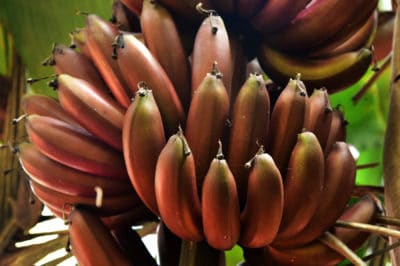About Bananas
The so-called banana tree is actually the largest member of the herb family, related to ginger and the bird of paradise flower. A perennial shrub, it has what looks like a trunk but is actually a compact whorl of leaf stems. Leaves grow from the center of the whorl and after nine months or more, a flower stem sprouts from the center and blooms.
How Bananas Grow
Bananas have an unusual development pattern compared to most other fruits. The single flower on the shrub opens over the course of several days. Bananas begin to develop almost immediately from the female flowers; they don’t need to be pollinated. Once the fruit develops to its mature size – which takes only a few days – it can take another three months to be harvest-ready.
About Edible Banana Varieties
In addition to the commercial banana, which is a tropical fruit, many bananas and plantains can be grown in USDA Zones 7 to 11. Plantains must be cooked before eating. These are edible varieties:
- Lady Finger or Nino
- Inarnibal or Señorita
- Dwarf Cavendish
- Musa “Double”
- French Plantains
- Apple or Manzano.
Developing Bananas
When the bananas – groups in clusters called “hands” and known as “fingers” – first appear, they point downward. As they continue to develop, the fingers turn upward. Initially, they have a well-defined ridge, but as development continues, the fruit plumps up and fills the ridges. It is the ridges that make bananas peel in strips.
Other Signs of Development
As bananas begin to ripen, the clusters of the fruit become quite heavy. The shrub may begin to lean over from the weight and must be supported with stakes. The color of the skin will gradually lighten from dark green to light green and finally to yellow. When squeezed, the fruit will feel supple and resilient, and give slightly.
Harvesting Bananas
It’s best to pick bananas when they reach the light green stage, with a few streaks of yellow. If you wait until the fruit it completely yellow, rodents and bugs will have already started eating the fruits. The ridges will be almost flat. Allow harvested bananas to fully ripen in a cool area until spotted with brown or black for best flavor and texture.
